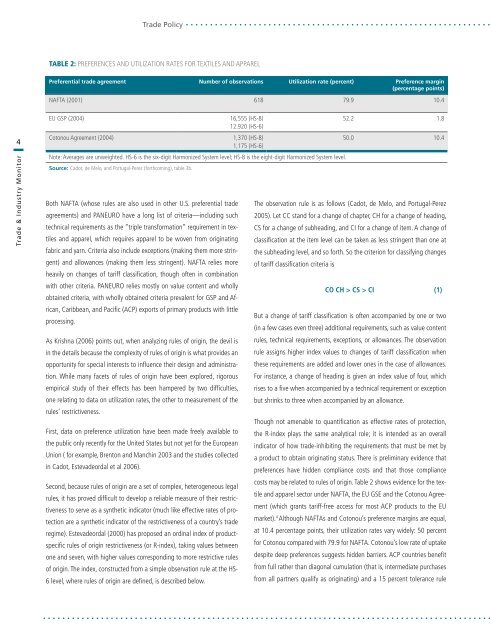Monitor Vol 39 08_Final_Nov08.pdf - tips
Monitor Vol 39 08_Final_Nov08.pdf - tips
Monitor Vol 39 08_Final_Nov08.pdf - tips
Create successful ePaper yourself
Turn your PDF publications into a flip-book with our unique Google optimized e-Paper software.
Trade Policy<br />
Table 2: Preferences and Utilization Rates for Textiles and Apparel<br />
Preferential trade agreement Number of observations Utilization rate (percent) Preference margin<br />
(percentage points)<br />
NAFTA (2001) 618 79.9 10.4<br />
4<br />
Trade & Industry <strong>Monitor</strong><br />
EU GSP (2004)<br />
16,555 (HS-8)<br />
52.2 1.8<br />
12.920 (HS-6)<br />
Cotonou Agreement (2004)<br />
1,370 (HS-8)<br />
50.0 10.4<br />
1,175 (HS-6)<br />
Note: Averages are unweighted. HS-6 is the six-digit Harmonized System level; HS-8 is the eight-digit Harmonized System level.<br />
Source: Cadot, de Melo, and Portugal-Perez (forthcoming), table 3b.<br />
Both NAFTA (whose rules are also used in other U.S. preferential trade<br />
agreements) and PANEURO have a long list of criteria—including such<br />
technical requirements as the “triple transformation” requirement in textiles<br />
and apparel, which requires apparel to be woven from originating<br />
fabric and yarn. Criteria also include exceptions (making them more stringent)<br />
and allowances (making them less stringent). NAFTA relies more<br />
heavily on changes of tariff classification, though often in combination<br />
with other criteria. PANEURO relies mostly on value content and wholly<br />
obtained criteria, with wholly obtained criteria prevalent for GSP and African,<br />
Caribbean, and Pacific (ACP) exports of primary products with little<br />
processing.<br />
As Krishna (2006) points out, when analyzing rules of origin, the devil is<br />
in the details because the complexity of rules of origin is what provides an<br />
opportunity for special interests to influence their design and administration.<br />
While many facets of rules of origin have been explored, rigorous<br />
empirical study of their effects has been hampered by two difficulties,<br />
one relating to data on utilization rates, the other to measurement of the<br />
rules’ restrictiveness.<br />
First, data on preference utilization have been made freely available to<br />
the public only recently for the United States but not yet for the European<br />
Union ( for example, Brenton and Manchin 2003 and the studies collected<br />
in Cadot, Estevadeordal et al 2006).<br />
Second, because rules of origin are a set of complex, heterogeneous legal<br />
rules, it has proved difficult to develop a reliable measure of their restrictiveness<br />
to serve as a synthetic indicator (much like effective rates of protection<br />
are a synthetic indicator of the restrictiveness of a country’s trade<br />
regime). Estevadeordal (2000) has proposed an ordinal index of productspecific<br />
rules of origin restrictiveness (or R-index), taking values between<br />
one and seven, with higher values corresponding to more restrictive rules<br />
of origin. The index, constructed from a simple observation rule at the HS-<br />
6 level, where rules of origin are defined, is described below.<br />
The observation rule is as follows (Cadot, de Melo, and Portugal-Perez<br />
2005). Let CC stand for a change of chapter, CH for a change of heading,<br />
CS for a change of subheading, and CI for a change of item. A change of<br />
classification at the item level can be taken as less stringent than one at<br />
the subheading level, and so forth. So the criterion for classifying changes<br />
of tariff classification criteria is<br />
CO CH > CS > CI (1)<br />
But a change of tariff classification is often accompanied by one or two<br />
(in a few cases even three) additional requirements, such as value content<br />
rules, technical requirements, exceptions, or allowances. The observation<br />
rule assigns higher index values to changes of tariff classification when<br />
these requirements are added and lower ones in the case of allowances.<br />
For instance, a change of heading is given an index value of four, which<br />
rises to a five when accompanied by a technical requirement or exception<br />
but shrinks to three when accompanied by an allowance.<br />
Though not amenable to quantification as effective rates of protection,<br />
the R-index plays the same analytical role; it is intended as an overall<br />
indicator of how trade-inhibiting the requirements that must be met by<br />
a product to obtain originating status. There is preliminary evidence that<br />
preferences have hidden compliance costs and that those compliance<br />
costs may be related to rules of origin. Table 2 shows evidence for the textile<br />
and apparel sector under NAFTA, the EU GSE and the Cotonou Agreement<br />
(which grants tariff-free access for most ACP products to the EU<br />
market). 4 Although NAFTAs and Cotonou’s preference margins are equal,<br />
at 10.4 percentage points, their utilization rates vary widely: 50 percent<br />
for Cotonou compared with 79.9 for NAFTA. Cotonou’s low rate of uptake<br />
despite deep preferences suggests hidden barriers. ACP countries benefit<br />
from full rather than diagonal cumulation (that is, intermediate purchases<br />
from all partners qualify as originating) and a 15 percent tolerance rule
















